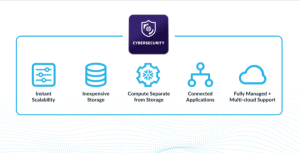Enhancing Fraud Detection in Finance with AI/ML and Snowflake
Introduction to AI-Driven Fraud Detection and Its Importance in Today’s Digital Landscape
Businesses today face a range of sophisticated attacks ranging from Phishing, Malware, Ransomware, data breaches and DDoS to insider threats and social engineering. As businesses increase the usage of newer technology like IoT and AI, the number of attack vectors only increases. It is no longer humanly possible to monitor every action / event / entry point to keep cybercriminals out. AI (designed and leveraged properly) can help strengthen the first and second lines of defense and mitigate risk.
AI-driven fraud detection analyzes vast amounts of data in real time using advanced algorithms and machine learning techniques. The systems can identify patterns and anomalies that could indicate fraudulent activity, providing organizations with a crucial layer of protection. Considering today’s cybersecurity trends, companies wishing to stay on top of evolving threats must integrate AI into fraud detection strategies or risk falling prey to newer types of threats or even existing threats hitting the business at scale.

Snowflake: The Platform Behind Advanced Security Analytics
Snowflake is a cloud data warehouse solution that allows businesses to store and analyze data efficiently. Its unique architecture separates compute from storage, enabling scalable analytics tailored to any organization’s needs.
One of Snowflake’s key features is its ability to handle diverse data types and workloads seamlessly including structured, semi-structured, and unstructured data through its innovative architecture. This versatility, combined with elastic scalability, multi-cloud support, and automated management, makes it an attractive solution for companies seeking robust data analytics capabilities. By optimizing performance and enabling secure collaboration across various environments, Snowflake empowers organizations to harness their data effectively while maintaining cost efficiency. Moreover, Snowflake’s architecture allows concurrent use by multiple users without compromising performance, enabling teams to collaborate effectively on security-related insights.
As part of the Snowflake platform, advanced security features are included to deliver comprehensive data protection while providing powerful analytical tools. Using Snowflake, businesses can better harness their data to enhance their decision-making abilities and security by integrating cloud technology with innovative architecture.
Key Features of Snowflake that Enhance AI-Driven Fraud Detection
Snowflake offers several key features that significantly enhance AI-driven fraud detection strategies for financial institutions.
Automated Anomaly Detection:
Snowflake’s anomaly detection capabilities scan vast datasets automatically to spot unusual patterns. Real-time monitoring makes detection and response to suspicious activity possible, crucial to mitigating fraud risks
Advanced Machine Learning Algorithms:
Machine learning algorithms continuously improve the platform’s accuracy based on historical data. As a result, compliance teams can focus on suspicious transactions rather than false positives.
Scalability and performance:
Snowflake uses robust cloud infrastructure to handle large datasets efficiently, enabling financial institutions to analyze data from multiple sources without performance degradation.
Separation of Compute and Storage:
Snowflake’s architecture decouples compute from storage, allowing organizations to scale each independently based on their needs. This flexibility ensures cost efficiency and high performance during fraud detection processes, as compute resources can be scaled up or down without affecting data storage or availability.
Integration with External Data Sources:
Snowflake allows seamless integration with third-party data providers, improving fraud detection models by incorporating diverse datasets. This feature supports a comprehensive risk assessment, and fraud detection efforts are more accurate.
Real-Time Analytics:
The platform’s ability to perform real-time analytics on streamed data empowers proactive fraud detection, enabling financial institutions to act quickly and effectively against potential threats.

The Role of Machine Learning in Enhancing Fraud Detection Capabilities
Machine learning is key in improving fraud detection capabilities by allowing systems to learn from vast amounts of data and identify patterns that may indicate fraud. Traditional rule-based systems often struggle to adapt to fraudsters’ ever-evolving tactics, leading to high rates of false positives and missed threats. Machine learning algorithms, on the other hand, can analyze historical transactions and uncover subtle anomalies and correlations that humans might overlook.
These algorithms continuously improve as they process updated data, allowing them to adapt to emerging fraud patterns quickly. Using techniques such as supervised learning to detect known fraud cases and unsupervised learning to detect novel threats, organizations can significantly increase their ability to detect and prevent fraud, safeguarding their assets and maintaining customer trust.
Critical applications:
- Credit card fraud prevention: ML detects fraudulent card testing bots and stolen credential reuse by analyzing spending patterns, device fingerprints, and behavioral biometrics.
- Banking transaction monitoring: Identifies money laundering networks through graph analysis, flagging accounts with sudden high-value transfers or circular payments.
- Account takeover detection: Perform an audit of login attempts to detect red flags such as VPN usage, atypical session lengths, or spikes in password reset requests.
- Identity verification: Combines facial recognition and liveness checks with document authenticity analysis to block synthetic identities.
Case Study- NutaNXT: Real-Time Fraud Detection for a Leading Financial Institution
Problem Statement: A prominent financial institution faced escalating fraud risks due to fragmented data systems and outdated technology. Their data was siloed across various geographies, transaction systems, and business lines, making it difficult to track fraudulent activities or meet regulatory requirements such as Know Your Customer (KYC) and Anti-Money Laundering (AML) compliance. This lack of integration resulted in delayed detection of fraud, increased financial losses, and significant penalties for non-compliance. The institution needed a comprehensive solution to consolidate its data, enable real-time fraud detection, and ensure compliance with regulatory frameworks.
Analysis by NutaNXT: NutaNXT conducted an in-depth analysis of the institution’s challenges, focusing on the following areas:
- Data Silos: Identified fragmented data sources across departments and regions that hindered holistic fraud detection.
- Volume and Velocity: Assessed the institution’s inability to process millions of transactions in real time due to legacy systems.
- Compliance Gaps: Evaluated deficiencies in meeting KYC and AML regulations, which exposed the institution to financial penalties.
- Fraud Patterns: Analyzed historical transaction data to uncover common fraud patterns and anomalies that could inform future detection models.
By leveraging Snowflake’s capabilities, NutaNXT proposed a unified approach to address these challenges.
Solution: NutaNXT deployed Snowflake’s multi-cluster shared data architecture to transform the institution’s fraud prevention capabilities. Key components of the solution included:
- Data Consolidation: Integrated all customer, transaction, and risk data into a centralized Snowflake platform, eliminating silos.
- Real-Time Analytics: Enabled near real-time fraud detection by implementing Snowflake Streams and Tasks for incremental updates without aggregating entire datasets.
- Machine Learning Models: Leveraged Snowpark ML to develop predictive models that identified anomalies and flagged suspicious transactions.
- Enhanced Governance: Used features like Dynamic Data Masking and end-to-end encryption to ensure secure access while maintaining compliance with KYC/AML regulations.
Outcome: The implementation by NutaNXT yielded significant benefits for the financial institution. Key outcomes included reduced fraud detection time from hours to seconds, enabling immediate action on suspicious activities, decrease in financial losses by more than 50% due to fraud, achieving full compliance with KYC/AML regulations, enhancing operational efficiency through streamlined workflows, and improving customer trust by proactively protecting accounts.
These improvements collectively strengthened the institution’s market position and reputation.
Conclusion: Leveraging AI-Driven Solutions like Snowflake to Stay Ahead of Cyber Threats and Protect Your Business
In conclusion, AI-driven fraud detection, supported by platforms like Snowflake, is essential for businesses to stay ahead of evolving cyber threats, protect customer trust, and maintain brand reputation in the increasingly digitized world. By leveraging AI and cloud-based solutions like Snowflake, organizations can transform their approach to security, moving from reactive measures to proactive, real-time threat detection and prevention.
This shift not only minimizes financial losses and ensures regulatory compliance but also strengthens the overall resilience of the business against increasingly sophisticated cyberattacks, fostering a safer and more secure environment for both the organization and its customers.

